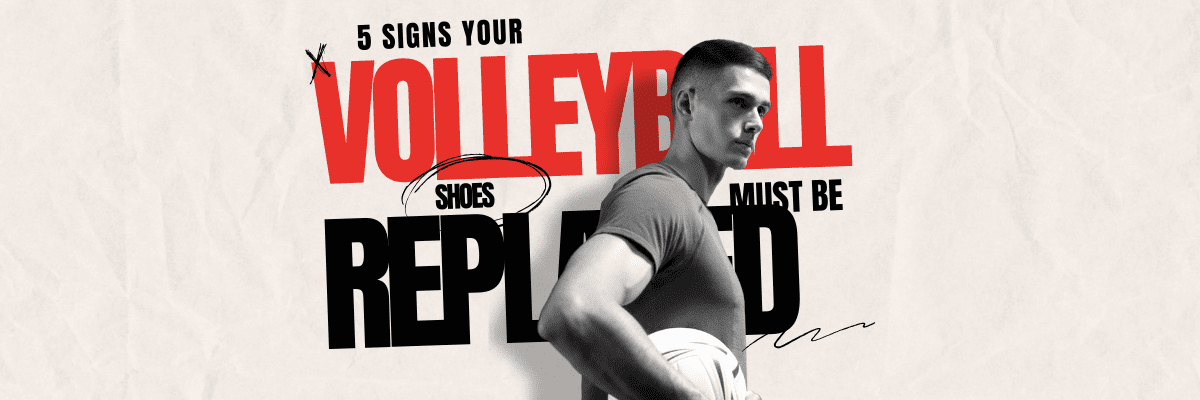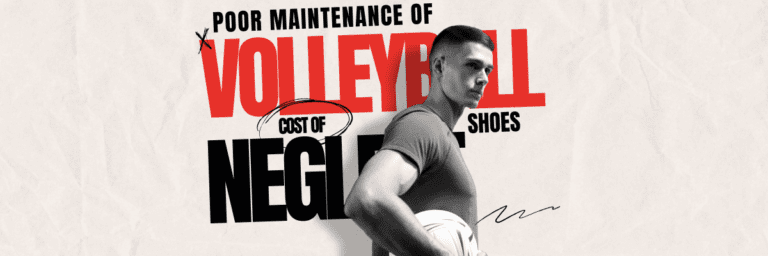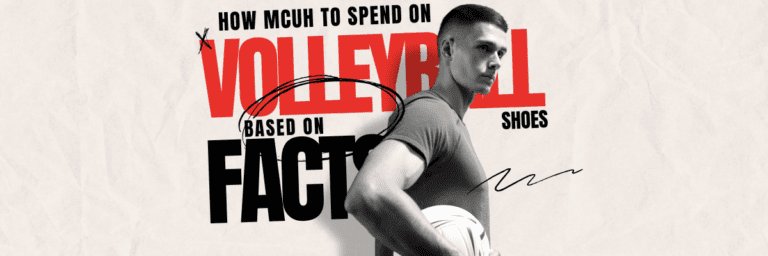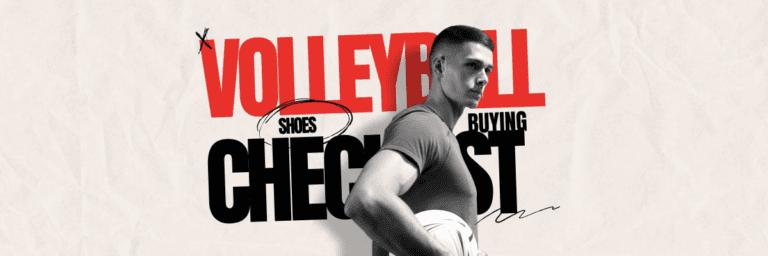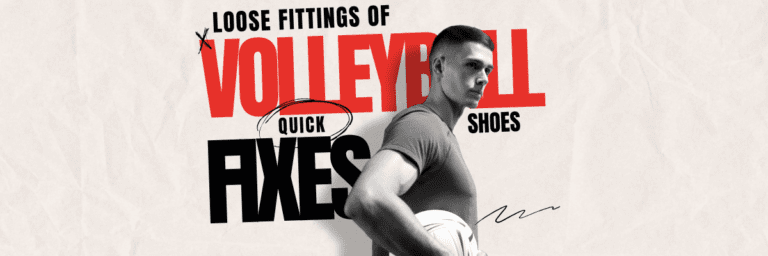The Top 5 Signs Your Volleyball Shoes Need Replacement
Introduction
The Tale of Sarah’s Slip-Up
Sarah, a spirited high school volleyball star, was about to make the game-winning spike. The crowd was on the edge of their seats, her teammates were holding their breaths, and BAM! Her foot slipped just as she jumped, sending her tumbling to the floor. No spike, no win, and worst of all a sprained ankle. So, what went wrong? You guessed it worn-out volleyball shoes that should’ve been retired ages ago. Ouch, right? If you don’t want to end up like Sarah, stick around, folks.
Importance
Shoes, The Unsung Heroes of Volleyball
Now, let’s get serious for a sec. Volleyball might be all about killer spikes, impressive digs, and that adrenaline-pumping action, but have you ever stopped to think about the MVPs that hardly get any limelight? Yup, your shoes! They’re not just there to match your stylish uniform; they’re your frontline defense against slips, falls, and all those “Oh no, why did I do that?” moments. Good shoes give you the grip, support, and springiness you need to bring your A-game. Bad shoes, well, they bring sprained ankles and a lot of heartbreak.

Overview
The “Sole” of the Matter
If you’re scratching your head, wondering whether your volleyball shoes are past their prime, you’re in luck. This article is your go-to guide for the top 5 signs that scream, “Replace me, for the love of all things sporty!” We’re going to talk about everything from worn-out soles to your sneaky performance dips, and even why your shoes might be, ahem, stinking up your game. So, lace up and let’s get this show on the road!
| Sign No. | Issue | Implication |
|---|---|---|
| 1 | Worn-Out Soles | Affects performance/risks injury |
| 2 | Inadequate Cushioning | Reduced grip on court |
| 3 | Uneven Wear and Tear | Diminished support/cushioning |
| 4 | The Smell Test | Potential discomfort during play |
| 5 | Performance Decline | Alters movement or jumping capabilities |
Sign 1: Worn-Out Soles
Explanation
The Tell-Tale Signs of Sole Sabotage
You know that balding tire look cars get when they’ve been around the block a few too many times? Well, your volleyball shoes can get that too! When the pattern on the soles starts looking flatter than a pancake on a Sunday morning, you’ve got yourself a problem. Those little ridges and patterns aren’t just for show; they’re designed to give you maximum grip on the court. Without them, you’re essentially trying to play volleyball on ice skates and we all know how that ends.
| Sole Problem | Visual Sign | Impact on Gameplay |
|---|---|---|
| Worn-out sole | Thinning/holes | Reduced traction |
| Uneven wear | Lopsided appearance | Alters foot alignment and movement |
| Damaged grip | Smoothened patches | Slipping on court during quick movements |
Consequence
Slippin’ and Slidin’ Isn’t Part of the Game
Imagine you’re all set for a killer serve. You throw the ball up, take a step back, and woah! Your feet slide out from under you like a cartoon character stepping on a banana peel. Now, that might be hilarious in a comedy skit, but in a serious game? It’s anything but. Playing with worn-out soles is like playing Russian Roulette with your safety. You might escape unscathed for a while, but sooner or later, you’re going to take a nasty spill. And let’s not forget, you could end up costing your team the game. No pressure, eh?
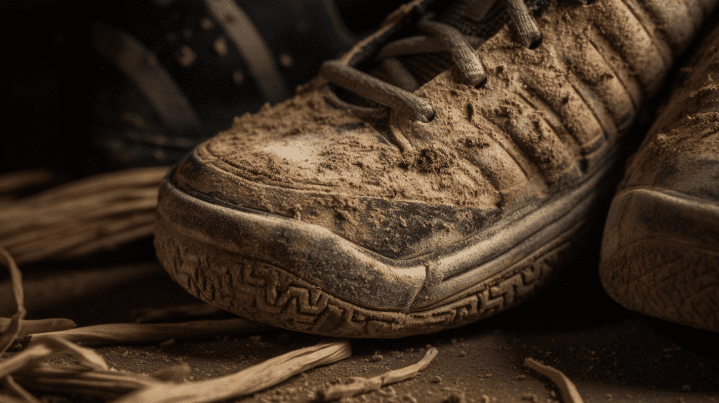
Expert Quote
The Sole Truth from the Pros
As famed sports podiatrist Dr. Footsy (yes, that’s his real name, no kidding) says,
“The grip of your shoes is not just about performance; it’s about safety. Your feet are your foundation. If they’re not secure, nothing is.”
So, if you’ve been shrugging off the wear and tear on your soles, take it from Dr. Footsy you’re putting more than just your game at risk.
Sign 2: Inadequate Cushioning
Explanation
The Slow Deflation of Your Bouncy Castle
Ah, remember the first time you slipped on those volleyball shoes? It felt like stepping onto a cloud or better yet, a mini bouncy castle for your feet! Fast forward a few months, and now it feels like you’re landing on a stack of bricks. What gives? The cushioning, my friend, has called it quits. Just like that irresistible marshmallowy filling in a donut, cushioning tends to deflate over time, making your landings harder and, well, not-so-sweet.

Consequence
When Tired Feet Aren’t Just “Tired”
We’ve all heard someone say, “Man, my feet are killing me!” But what if your shoes are actually plotting your athletic demise? Kidding, of course, but inadequate cushioning is no laughing matter. Without proper support, you’re not just courting discomfort; you’re rolling out the welcome mat for fatigue, shin splints, and even stress fractures. So yeah, if your shoes feel about as cushiony as a wooden plank, it might be time to give them the ol’ heave-ho.
DIY Test
The “Thumb Press” Reality Check
Ready for a simple, no-fuss test to check your shoe’s cushioning? It’s called the “Thumb Press Test,” and it’s as easy as pie. All you’ve got to do is press your thumb into the shoe’s cushioning, especially in the heel and forefoot areas. Does it bounce back like a trampoline or does it cave in like a deflated balloon? If it’s the latter, it’s time to say adios to those beat-up sneaks.
So, there you have it! A simple way to test if the spring in your step has lost its “springiness.” Don’t play the waiting game until you’re nursing an injury or till your teammates nickname you “Ol’ Wooden Feet.” Keep that bounce in your step, literally, by ensuring your shoes are up to the challenge. Ready to tackle the next sign? Trust me; it’s a stinker!
Sign 3: Uneven Wear and Tear
Explanation
The Lopsided Love Affair
You ever see a car with one flat tire trying to hobble its way down the road? Not a pretty sight, right? Well, uneven wear on your volleyball shoes is kind of like that; it can make your game hobble along, looking all sorts of wonky. Spotting uneven wear isn’t rocket science; one look at the soles and you’ll see one side looking a bit more worn down than the other. It’s like one side partied hard while the other stayed in to study, and now they’re not on the same page.
Consequence
The Crooked Path to Mediocre Moves
Let’s get real here; uneven wear is more than just an aesthetic eyesore. It messes with your posture and balance, big time. Imagine trying to serve with one side of your body higher than the other. You’d look like the Leaning Tower of Pisa trying to play volleyball. And guess what? Your serves, spikes, and digs will lean towards failure too. You may not notice it right away, but over time, this unevenness can lead to muscle imbalances and even put extra stress on your joints. In a nutshell, you’re hobbling your way to poor performance and potential injuries.
Photo Comparison
A Picture is Worth a Thousand Groans
| Feature/Aspect | Old Shoes | New Shoes |
|---|---|---|
| Sole Grip | Worn out patches | Fresh, textured grip |
| Cushioning | Flattened/uneven | Plump and even |
| Outer Material | Frayed/tears | Intact, fresh appearance |
If words don’t do it for you, photos sure will. Take a gander at side-by-side photos of new vs. unevenly worn shoes, and it’ll hit you like a ton of bricks. On one side, you’ll see the fresh, evenly textured soles of a brand-new pair of volleyball shoes, ready to tackle any challenge. On the other, you’ll see the lopsided, unevenly worn soles that scream, “Help me, I’ve fallen, and I can’t get up!”
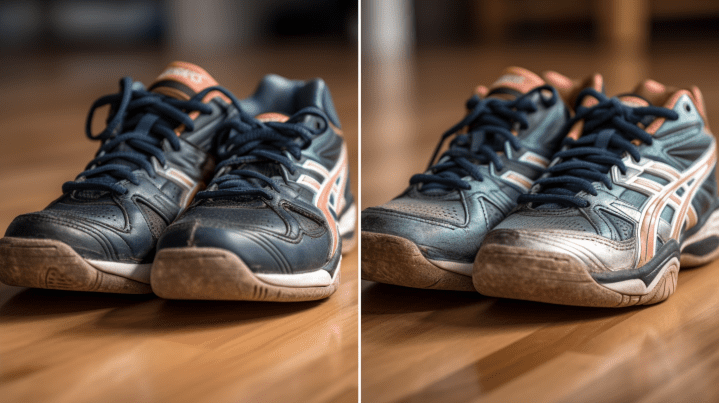
Sign 4: The “Smell Test”
Explanation
When Your Shoes Cry “Eau De No Way!”
Hold your nose; we’re diving into stinky territory! You know how your grandma would always say, “If it smells fishy, there’s something wrong”? She wasn’t talking about volleyball shoes, but boy, does it apply. A bad odor isn’t just a social faux pas that makes your teammates wish they had a clothespin for their noses. No, my friend, that foul smell is like your shoe’s desperate SOS call. It signals material breakdown, which often happens when sweat, dirt, and bacteria pull a sinister coup on your shoe’s interior.
| Cause of Odor | Implication | Solution |
|---|---|---|
| Material breakdown | Reduced shoe effectiveness | Consider replacement |
| Bacterial growth | Possible foot infections | Regular cleaning and drying |
| Lack of ventilation | Accelerated wear and tear | Use moisture-wicking socks, air out shoes |
Consequence
When Your Game Stinks, Literally
If you think a bad odor is just a minor inconvenience, think again. As the material inside your shoes breaks down, so does their effectiveness. A decaying inner sole can lead to reduced support and cushioning. Next thing you know, you’re not just the player with the stinky shoes; you’re the player with stinky and lousy moves. Broken-down material can also lead to discomfort, blisters, and even fungal infections. Yikes, right? So, as much as you might love those old, stinky shoes, they’re basically sabotaging your game and your foot health.

Quick Fixes
The Band-Aids of the Shoe World
Sure, there are temporary fixes like shoe sprays, deodorizers, or even throwing your shoes in the freezer (yeah, people do that). But let’s be clear, these are short-term solutions to a long-term problem. It’s like putting a band-aid on a wound that really needs stitches. Eventually, you’ll need to face the music and replace those stinky saboteurs.
So, the next time you’re tempted to ignore that nose-crinkling smell emanating from your volleyball bag, remember: those shoes are sending you a message. And it’s not just “I need a bath”; it’s “I need to be replaced, stat!” Still hanging in there? Good, because our final sign is a real eye-opener!
Sign 5: Your Performance is Taking a Hit
Explanation
The Silent Saboteur in Your Game
Ah, performance a word that sets every athlete’s heart aflutter. You’ve been practicing like a pro, so why are you suddenly more “meh” than “MVP”? You’ve checked your form, your diet, even your sleep schedule, but did you think about those battered old shoes you’re wearing? Yep, just like that stealthy ninja in the movies, poor-performing shoes are the silent killer of your game. They might not be shouting their defects, but oh boy, are they making themselves known in how you move and play.

Consequence
The Slow Fade of Your Athletic Prowess
When your shoes start giving up on you, it’s like they’re pulling the rug from under your athletic skills. You might find yourself a step slower, a jump shorter, or even worse a fall harder. Your agility takes a hit, your speed wanes, and suddenly that spike you could always land starts feeling like a mission to the moon. Remember, volleyball is a sport that demands the most from your feet. If your shoes aren’t up to snuff, you’re basically trying to win a race with an anchor tied to your ankles.
Expert Quote
Wisdom From the Coaching Corner
Coach “Spike” Johnson, a seasoned volleyball coach and part-time sports scientist, puts it best,
“Footwear in volleyball is not just about looking good; it’s an extension of your skill set. If you’re playing in shoes that are past their prime, you’re not just risking injury you’re willingly handicapping your performance.”
So, there you have it. If you’re struggling on the court and can’t figure out why, give those shoes a long, hard look. They could be the sneaky culprit behind your sudden slump. It’s not just about keeping up with the latest styles or trends; it’s about being at the top of your game, literally. Are you ready to give those old shoes the boot and reclaim your volleyball mojo? I thought so!
General Tips
| Tip/Aspect | Description |
|---|---|
| Fit of the shoe | Should be snug but not tight; ensure toes have wiggle room |
| Signs of wear | Look for uneven soles, reduced grip, or persistent bad odor |
| Performance indicators | Slipping, difficulty in jumping, or unusual foot fatigue |
Conclusion
Recap
The Shoe Must Go On Or Maybe Not!
Well, folks, we’ve had quite the journey, haven’t we? From worn-out soles that lost their grip on reality to cushioning that deflated faster than a balloon at a porcupine party, we’ve covered it all. And let’s not forget our stinky little friends that tried to pass as ‘just fine.’ These signs aren’t just caution flags; they’re blaring sirens saying, “Houston, we have a problem!” Ignoring these signs is like pretending the ‘check engine’ light in your car is just a decorative feature. Bad idea!
Don’t Just Stand There; Do Something!
So you’ve read the signs, and you’re starting to get that sinking feeling? Well, don’t just stand there like a deer in headlights; act on it! Dust off those shoes, give them a good once-over, and decide their fate. Whether it’s a thorough cleaning, some minor repairs, or chucking them in the “shoe-tirement” bin, the point is to take action. Your feet and your game will thank you.
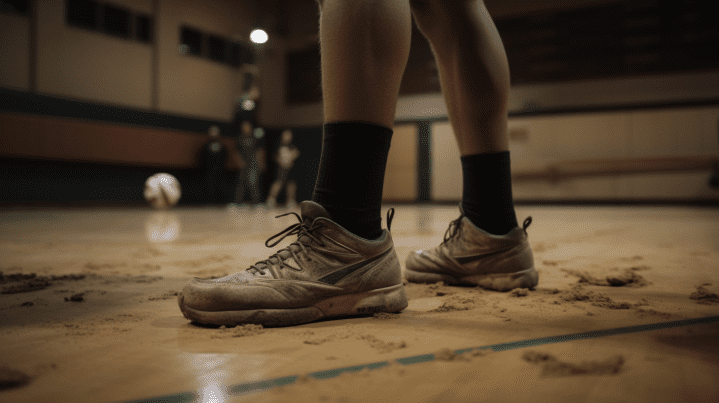
Final Thoughts
If The Shoe Fits, Keep It
If you’ve made it this far, you deserve a reward. So, here’s a personal tip: If durability and performance are at the top of your list, consider brands like Mizuno or ASICS. These brands are often the go-to choices for pros and amateurs alike. They offer the Cinderella combo of comfort, durability, and peak performance. No, they won’t turn you into the next volleyball superstar overnight, but they’ll sure give you a sturdy foundation to build on.
Frequently Asked Questions (FAQs)
How do you know when you need new volleyball shoes?
Look out for telltale signs like worn-out soles, poor cushioning, uneven wear and tear, or a lingering bad odor. Your performance on the court can also be a big clue. If you’re slipping, finding it hard to jump, or your feet are in pain, it’s time to consider a new pair.
When should you replace shoes?
Ideally, you should replace volleyball shoes every season if you play frequently. However, it really depends on the shoe’s condition. Key indicators include grip loss, discomfort, and visible wear and tear.
How long does it take to break in volleyball shoes?
Breaking in times can vary, but generally, it takes about two weeks of regular playing to break in new volleyball shoes. Some high-quality shoes might feel comfortable right out of the box, but giving them time to adapt to your feet ensures better performance.
What are the best type of shoes for volleyball?
The best shoes for volleyball offer a balance of grip, support, and cushioning. Brands like Mizuno and ASICS are often favored. Look for a lightweight design, good ankle support, and excellent traction to facilitate quick moves.
Should volleyball shoes be tight or loose?
Volleyball shoes should be snug but not tight. You need a secure fit to prevent blisters and offer good support but room enough for your toes to move. A tight fit can restrict movement and become uncomfortable.
Should volleyball shoes be slippery?
No, volleyball shoes should not be slippery. Good grip is essential for quick lateral movements, stops, and jumps. A slippery shoe can be dangerous and affect your performance negatively.
How do I know if my shoes are worn out?
Aside from visual signs like frayed material or uneven soles, you’ll notice a loss of grip and comfort. Your movements might also be less precise, and you may experience unusual fatigue or foot pain after playing.
Do new shoes hurt at first?
New shoes can be uncomfortable initially as they adapt to your foot shape. However, if they continue to hurt after a few weeks, they might not be the right fit or type for you.
What happens if you don’t replace shoes?
Continuing to play in worn-out shoes can lead to poor performance, increased risk of injury, and even long-term foot issues. You’ll likely see a decrease in agility, speed, and general comfort, affecting your game substantially.

